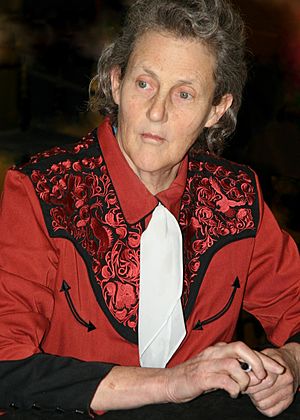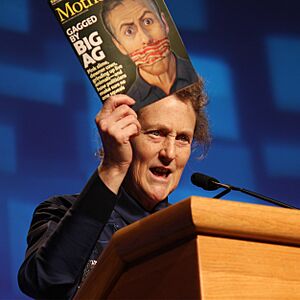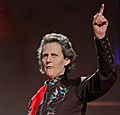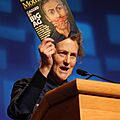Temple Grandin facts for kids
Quick facts for kids
Temple Grandin, Ph.D.
|
|
|---|---|

Grandin in 2011
|
|
| Born |
Mary Temple Grandin
August 29, 1947 Boston, Massachusetts, U.S.
|
| Alma mater |
|
| Known for |
|
| Scientific career | |
| Fields |
|
| Institutions | Colorado State University |
| Author abbrev. (zoology) | Grandin |
Mary Temple Grandin (born August 29, 1947) is an amazing American scientist, inventor, and animal expert. She is famous for helping people understand and treat farm animals kindly. Temple Grandin has written many scientific papers about how animals behave. She also works as a consultant, giving advice to the livestock industry on animal behavior.
Temple Grandin is one of the first people with autism to share her personal experiences. She has helped many people understand what it's like to be autistic. She is a professor at Colorado State University in the Animal Sciences department.
In 2010, Time magazine named her one of the 100 most influential people in the world. A movie about her life, called Temple Grandin, won several awards. Temple Grandin is also a strong supporter of autism rights and the idea of neurodiversity. This means celebrating the different ways people's brains work.
Contents
Temple Grandin's Early Life
Her Family and Childhood
Temple Grandin was born in Boston, Massachusetts, into a well-known family. Her mother, Anna Eustacia Purves, was an actress and singer. Her father, Richard McCurdy Grandin, was a real estate agent. He came from a family that owned a very large wheat farm business.
Temple's parents divorced when she was 15. Her mother later married Ben Cutler, a musician. Temple has three younger siblings: two sisters and a brother. One of her sisters has dyslexia, which means she has difficulty reading.
Understanding Her Diagnosis
Temple Grandin was not officially diagnosed with autism until she was an adult. When she was two years old, doctors thought she had "brain damage." However, later tests showed this was not true. When Temple was a teenager, her mother found a checklist for autism. She realized that many of the things on the list described Temple.
Later, it was understood that Temple is an autistic savant. This means she has autism but also has special abilities, like an amazing visual memory.
Early Childhood Experiences
When Temple was a toddler, doctors often suggested that children with her symptoms should live in special institutions. Her father agreed with this idea, but her mother strongly disagreed. Temple's mother looked for other options. She took Temple to top researchers at Boston Children's Hospital.
Eventually, a doctor suggested speech therapy. Temple started receiving special training from a speech therapist when she was two and a half. Her mother also hired a nanny to play games with Temple and her sister. Temple started kindergarten at Dedham Country Day School. Her teachers and classmates tried to help her with her needs and sensitivities.
Temple has said that she was lucky to have supportive teachers from elementary school. However, she found junior high and high school to be very difficult times.
Middle School and High School Years
Temple Grandin attended Beaver Country Day School for a few years. She was expelled at age 14 for throwing a book at a classmate who teased her. Temple described herself as the "nerdy kid" whom everyone made fun of. Students would call her a "tape recorder" because she would repeat things. She said that even though she can laugh about it now, it hurt a lot back then.
After her expulsion, Temple's mother enrolled her at Hampshire Country School in New Hampshire. This school was for students with "exceptional potential" who had not done well in typical schools. Temple was accepted there and even became the Winter Carnival Queen and captain of the hockey team.
At Hampshire Country School, Temple met William Carlock, a science teacher who had worked for NASA. He became a very important mentor to her. Mr. Carlock helped Temple gain confidence. He encouraged her to build her squeeze machine (also called a hug box). Temple got the idea for this machine after visiting her aunt's ranch in Arizona. She saw how cattle were calmed by a squeeze chute. With Mr. Carlock's help, she built her own hug box when she was 18.
Higher Education and Learning
After graduating from Hampshire Country School in 1966, Temple Grandin continued her education. She earned her bachelor's degree in psychology from Franklin Pierce College in 1970. Then, she got a master's degree in animal science from Arizona State University in 1975. Finally, she earned her doctoral degree (PhD) in animal science from the University of Illinois at Urbana–Champaign in 1989.
Temple Grandin's Career and Contributions
Understanding Autism Spectrum
Temple Grandin helped change how people view autism. She was one of the first adults to openly share that she was autistic. Her first book, Emergence: Labeled Autistic, was published in 1986. In this book, she shared her feelings and fears. She also explained how her mind worked. This gave many people a new understanding of autism.
In her later book, Thinking in Pictures, published in 1995, a famous neurologist named Oliver Sacks wrote that the book helped build "a bridge between our world and hers." It allowed readers to see into a different kind of mind.
At first, Temple described herself as "recovered" from autism. However, she later realized she hadn't recovered. Instead, she had learned to adapt to the social world around her with great effort.
Temple Grandin realized that not all autistic people think in the same way she does. She believes there are three main types of thinking:
- Visual Thinkers: Like her, they think in specific pictures, like a mental slideshow.
- Music and Math Thinkers: They think in patterns and are often good at math, chess, or computer programming.
- Verbal Logic Thinkers: They think in word details and might enjoy subjects like history.
Temple Grandin became widely known after being described in Oliver Sacks' book An Anthropologist on Mars in 1995. The title comes from how Temple felt around people who are not autistic. She said it was like being "an anthropologist on Mars."
Temple Grandin believes that early help for children with autism is very important. She also stresses the need for supportive teachers. These teachers can guide a child's strong interests in helpful ways. She has often talked about her sensitivity to loud noises and other sensory things. She says words are her second language. She thinks "totally in pictures" and uses her amazing visual memory to remember details. This helps her design humane livestock facilities.
As a supporter of neurodiversity, Temple Grandin believes that milder forms of autism should not be eliminated. However, she thinks that severely disabled and nonverbal autistic children need therapies to help them function.
Improving Livestock Handling
In 1980, Temple Grandin published her first scientific articles about how beef cattle behave when handled. She was one of the first scientists to notice that animals are sensitive to small visual distractions. These include shadows, dangling chains, or other details that most people don't see.
When she earned her PhD, she studied how different environments affect pigs. She found that calm cattle gained more weight. This was a new idea in 1997.
Temple Grandin also developed a special system for holding cattle at large meat processing plants. This system, called a center track conveyor restrainer, helps keep the animals calm. Many large meat companies now use it.
She also created a way to score how animals are handled and stunned at processing plants. Using this scoring system has greatly improved how animals are treated during slaughter.
In 2008, Temple Grandin published Humane Livestock Handling. This book explains cattle behavior and provides diagrams for building humane handling systems. Many of her ideas are also available on her website. She even helped design animal processing plants at an organic farm in Georgia.
Other Scientific Work
Temple Grandin has written or co-written over 60 scientific papers on many animal behavior topics. These include how hair patterns affect cattle behavior, how stress before slaughter affects meat quality, and the causes of bruising in animals.
Advocating for Animal Welfare

Temple Grandin has given many talks about her own experiences with anxiety. She felt threatened by her surroundings and often felt dismissed. This feeling motivates her work to improve how livestock are handled. She studied how cattle react to ranchers, movements, objects, and light.
She designed curved corrals that help reduce stress, panic, and injury in animals being led to slaughter. Some animal activists have questioned how she can work in the slaughterhouse industry and still claim to have compassion for animals. Temple Grandin explains that because of her autism, she can see the world from the animals' point of view. She feels a deep connection to them.
Her business website works to improve standards for slaughterhouses and livestock farms.
In 2004, Temple Grandin received an award from People for the Ethical Treatment of Animals (PETA) for her vision.
One of her important essays is "Animals Are Not Things." In it, she argues that while animals are legally considered property, they also have ethical protections. She compares owning cattle to owning screwdrivers. Both can be used by humans, but you can't torture an animal like you can smash a screwdriver.
Her understanding of animals has taught her to notice small details that animals are sensitive to. She uses her visualization skills to design thoughtful and humane animal-handling equipment. In 2009, she was recognized as a fellow of the American Society of Agricultural and Biological Engineers.
In 2012, when the beef industry faced concerns about "pink slime" (a meat product), Temple Grandin supported its use. She said it should be sold and labeled, so we don't waste beef.
Temple Grandin believes that using animals for food can be ethical. She says, "We've got to give those animals a decent life, and we've got to give them a painless death. We owe the animals respect."
Temple Grandin's Personal Life
Temple Grandin has shared that autism affects every part of her life. She chooses comfortable clothes to help with her sensory processing disorder. She also structures her life to avoid feeling overwhelmed by too much sensory input. She takes medication to help with her mood. She used to use her squeeze machine, but it broke a few years ago. She now prefers hugging people.
Awards and Honors
Temple Grandin has received many awards and honors for her work:
- In 2010, she was named one of the 100 most influential people in the world by Time magazine.
- In 2011, she received a Double Helix Medal.
- She has received honorary degrees from many universities around the world.
- In 2011, she was awarded the Ashoka Fellowship.
- In 2012, she was inducted into the Colorado Women's Hall of Fame.
- In 2015, she received a Meritorious Achievement Award from the World Organisation for Animal Health.
- In 2016, she was inducted into the American Academy of Arts and Sciences.
- In 2017, Temple Grandin was inducted into the National Women's Hall of Fame.
- In 2023, she received honorary Doctor of Science and Doctor of Veterinary Medicine degrees from universities.
Temple Grandin in Media
Temple Grandin has been featured on many TV shows, including Primetime Live, the Today Show, and Larry King Live. She has also been written about in magazines like Time, People, and Forbes, and in The New York Times.
She was the subject of a BBC documentary called "The Woman Who Thinks Like a Cow" in 2006. She was also featured in the first episode of the series First Person by Errol Morris.
A semi-biographical HBO film about her life, titled Temple Grandin, was released in 2010. Claire Danes played Temple Grandin in the movie. The film won many awards, including seven Primetime Emmy Awards and a Golden Globe Award for Claire Danes.
In 2018, Temple Grandin was featured in the documentary This Business of Autism, which looked at how autistic people find jobs. She was also featured in Michael Pollan's 2006 book, The Omnivore's Dilemma, where she discussed the livestock industry.
Temple Grandin has also been the subject of children's books. In 2017, Julia Finlay Mosca wrote The Girl Who Thought In Pictures, A Story of Temple Grandin. In 2023, Brad Meltzer and Chris Eliopoulos released I am Temple Grandin as part of the "Ordinary People Change the World" series. This book was later made into an episode for the PBS show Xavier Riddle and the Secret Museum.
Images for kids
-
Temple Grandin at TED in February 2010
See also
 In Spanish: Temple Grandin para niños
In Spanish: Temple Grandin para niños





